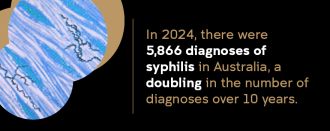Media release
From:
The briefing discussed the following issues:
- Increasing rates of syphilis and gonorrhoea over the last decade
- Significant gaps in sexual health testing in Australia
- Higher rates of STIs among Australia’s First Nations peoples
- HIV trending down
Speakers:
- Dr Skye McGregor - Kirby Institute
- Mr Robert Monaghan - Kirby Institute
Community Representatives:
- Jessica Michaels - ASHM
- Dash Heath-Paynter - Health Equity Matters
- Scott Harlum - NAPWHA (National Association of People with HIV Australia)
Australia’s 2024 sexual health checkup: increases in syphilis and gonorrhoea, chlamydia stable, and HIV declining
In 2024:
- there were 5,866 diagnoses of syphilis in Australia, a doubling in the number of diagnoses over 10 years.
- congenital syphilis cases more than doubled since 2015, with 34 infant deaths attributed to congenital syphilis in the past decade.
- there were 44,210 gonorrhoea diagnoses in Australia, a doubling of cases over 10 years.
- there were 101,742 diagnoses of chlamydia, around half of which were among people aged 20 to 29 years.
- rates of sexually transmissible infections remained higher among First Nations Australians.
- there were 757 HIV diagnoses, a 27% decline over the past decade.
(Monday 15 September, 2025) Over the past decade, syphilis and gonorrhoea diagnoses in Australia have more than doubled, chlamydia diagnoses remain high, and HIV has declined, according to the latest national surveillance data released today by the Kirby Institute at UNSW Sydney, at the Australasian HIV&AIDS Conference in Adelaide.
“Sexually transmissible infections can be passed on to others, but in most instances can be easily treated. However, if left untreated sexually transmissible infections can cause serious long-term health concerns like pelvic inflammatory disease, and infertility in women,” said Dr Skye McGregor, an epidemiologist at the Kirby Institute and the report’s lead author, who presented the data at the conference. “Importantly, people who are pregnant can pass on the infection to their babies causing serious harm. These data highlight areas of public health concern where efforts need to be focused.”
Other data show us there are significant gaps in sexual health in Australia. A recent analysis from the Australian Survey of Health and Relationships prepared by the Kirby Institute found that only 16% of Australians aged 16–49 years had ever been tested for a sexually transmissible infection (STI), and only one in two people had ever discussed sexual health with their health care providers.
“These data, on a backdrop of rising STIs, are concerning,” Dr McGregor said.
“Chlamydia, gonorrhoea and syphilis are easily treated and cured with antibiotics. Early testing, diagnosis and treatment prevents serious outcomes. HIV, while not curable, is highly treatable, and diagnosis and starting effective treatment early prevents poor health outcomes and interrupts onward transmission. These data are a reminder that regular sexual health testing, including syphilis and HIV, is crucial,” said Dr McGregor.
“Prevention is also an important part of driving down STIs. Condoms can reduce the risk of transmission of most STIs, which should be considered alongside other prevention approaches, such as regular testing and treatment. For gay and bisexual men, doxy PEP is also available, which involves taking the antibiotic, doxycycline within 72 hours of sex to reduce the risk of bacterial sexually transmitted infections, particularly syphilis and chlamydia.
“It’s important that everyone who is sexually active discusses sexual health with their partners, practices safe sex, has regular STI testing, and talks to their health care provider about their sexual health,” said Dr McGregor.
Syphilis increasing, with particular concern for congenital syphilis
In 2024, there were 5,866 diagnoses of syphilis in Australia, representing a doubling in the number of diagnoses over 10 years. While the majority of diagnoses are among men (8 in 10), syphilis diagnoses among women are increasing at a faster pace (quadrupling over the past decade).
The researchers say that the increases among women of childbearing age are particularly concerning.
“Syphilis is entirely curable, however if untreated in pregnancy, infection can lead to miscarriage or stillbirth, or congenital syphilis, which is when the infection is transmitted to an unborn child. Congenital syphilis is an extremely serious condition for infants that can result in significant lifelong health impacts, and in the most severe cases can be fatal,” said Dr McGregor.
Congenital syphilis cases have more than doubled since 2015, and tragically, 34 infant deaths have been attributed to congenital syphilis in the past decade. Of the deaths, more of than half were among First Nations Australians.
In August this year, Australia’s Chief Medical Officer and Director of the International Centre for Future Health Systems at UNSW Sydney Professor Michael Kidd declared syphilis a Communicable Disease Incident of National Significance, particularly due to concerns around congenital syphilis.
“By raising awareness among Australians – including healthcare professionals – we will help ensure more people get tested and treated for syphilis, so we can stop the spread of the disease,” Prof Kidd said in his statement.
Deputy CEO for ASHM, the peak organisation for health workers and medical professionals who work in HIV, blood borne viruses, and sexual and reproductive health Jessica Michaels said “the syphilis epidemic is going to take a sustained and coordinated response to resolve – from government, researchers, the clinical workforce and the community.”
Gonorrhea also on the rise
In 2024, there were 44,210 gonorrhoea diagnoses in Australia, representing a doubling of cases over 10 years. Like syphilis, most diagnoses (7 in 10) are in men. The gonorrhoea notification rate has been higher among males than females every year over the past decade.
“The disproportionately high number of gonorrhoea diagnoses among men compared to women indicates more frequent transmission through male-to-male sex,” said Professor Andrew Grulich, head of the HIV Epidemiology and Prevention Program at the Kirby Institute.
"It is likely that the increases can be explained by the availability of highly effective HIV prevention strategies, and a subsequent gradual decline in the use of condoms, together with more comprehensive STI screening."
Chlamydia relatively stable, though remains Australia’s most diagnosed STI
In 2024, there were 101,742 diagnoses of chlamydia, around half of which were among people aged 20 to 29 years.
“Although chlamydia diagnoses are not increasing at the same pace as syphilis or gonorrhoea, it is still the most common STI in Australia,” said Dr McGregor. “The risk of chlamydia can be reduced by using condoms and regular testing to ensure you know your status. If you are sexually active, particularly with a new partner, STI testing is crucial. A test for chlamydia is very straightforward, and the treatment is usually a single dose of antibiotics. Just speak to your health care provider,” said Dr McGregor.
Higher rates of STIs among Australia’s First Nations peoples
Rates of sexually transmissible infections remain high among First Nations Australians, with chlamydia diagnosed at more than twice the rate, gonorrhoea almost four times higher, and syphilis more than five times higher than in non-Indigenous people.
“These gaps are even starker in regional and remote areas,” said Robert Monaghan, a Bundjalung-Gumaynggir man and Manager of the Yandamanjang First Nations Health Research Program at the Kirby Institute. “What’s needed now is real investment in culturally safe, community-driven health promotion, testing and treatment. Declaring syphilis, a Communicable Disease Incident of National Significance is an important step. Sustainable change depends on culturally safe, community-led action.”
HIV diagnoses trending down
There were 757 HIV diagnoses in 2024, a 27% decline over the past decade. 62% of diagnoses were attributable to sex between men, 27% to sex among heterosexuals and 3% to injecting drug use.
While ten-year trends show a decline, there’s been a small increase in diagnoses over the past two years. “While the small increase is likely related to unusually low diagnoses during the COVID pandemic, during which there was a marked decline in both transmission risks and testing, the small increase is a reminder that Australia’s HIV transmission elimination journey is not over. We must enhance our elimination efforts,” said Dr McGregor.
Commenting on the data, Scott Harlum, President of the National Association of People with HIV Australia said: "while numbers of new HIV diagnoses are consistent with a decline over the past decade, we need to do much more if we are to reach virtual elimination of domestic HIV transmissions in Australia by 2030.
"It’s also important to remember that each of the 757 diagnoses are individuals - there is a face and a name behind every one of those 'data' - each with lived experience of the reasons why health systems have failed to prevent HIV transmission.
"This reinforces the critical importance of people with HIV sharing our lived experience so that we can build a better understanding of HIV and effectively plan a response which enables year-on-year declines in new cases until we reach the virtual elimination goal," Mr Harlum said.
Dash Heath-Paynter, CEO of Health Equity Matters, said that achieving the virtual elimination of Australian HIV transmission in Australia demanded renewed focus. “We’ve had great success in reducing HIV in Australia over the past decade, driven by community leadership. However, we need focused effort, so no one is left behind,” he said.
“HIV diagnoses have almost halved among Australian-born people over the past decade. However, for people born outside Australia, no reduction in HIV diagnoses was observed over the same period.
“We need to urgently implement health services that have been co-designed by the very people they serve. This is the best way to raise awareness of HIV among overseas-born people, increase the use of proven HIV prevention strategies and testing, and improve access to care,” said Mr Heath-Paynter.
In 2024, almost one third of HIV diagnoses were considered late. This means that the person diagnosed may have been living with HIV for four or more years without knowing their HIV status and may be experiencing HIV-related illnesses. Among heterosexuals, 51% of HIV diagnoses were classified as late.
“These high proportions of late diagnoses are very concerning. We need to ensure HIV testing is accessible, including self-testing, to ensure timely diagnosis and engagement in appropriate care for people with HIV,” said Dr McGregor.
Although HIV diagnoses among First Nations peoples declined by 43% over the past decade, the report’s authors suggest these trends should be interpreted with caution as the numbers are low year-on-year.
Multimedia








 Australia; NSW
Australia; NSW


